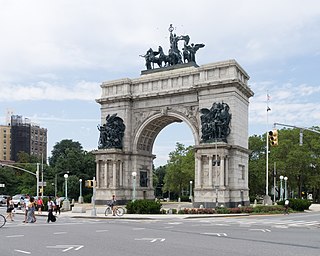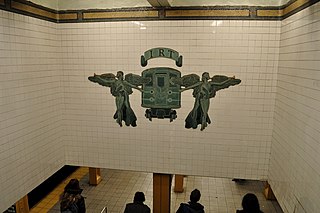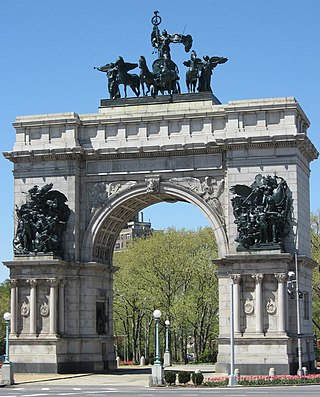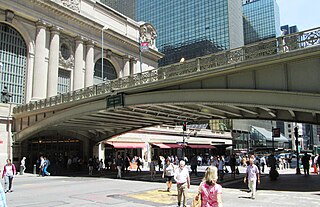
Prospect Park is an urban park in the New York City borough of Brooklyn. The park is situated between the neighborhoods of Park Slope, Prospect Heights, Prospect Lefferts Gardens, Flatbush, and Windsor Terrace, and is adjacent to the Brooklyn Museum, Grand Army Plaza, and the Brooklyn Botanic Garden. With an area of 526 acres (213 ha), Prospect Park is the second-largest public park in Brooklyn, behind Marine Park. Designated as a New York City scenic landmark and listed on the National Register of Historic Places, Prospect Park is operated by the Prospect Park Alliance and NYC Parks.

Grand Army Plaza, originally known as Prospect Park Plaza, is a public plaza that comprises the northern corner and the main entrance of Prospect Park in the New York City borough of Brooklyn. It consists of concentric oval rings arranged as streets, with the namesake Plaza Street comprising the outer ring. The inner ring is arranged as an ovoid roadway that carries the main street – Flatbush Avenue. Eight radial roads connect Vanderbilt Avenue; Butler Place; two separate sections of Saint John's Place; Lincoln Place; Eastern Parkway; Prospect Park West; Union Street; and Berkeley Place. The only streets that penetrate to the inner ring are Flatbush Avenue, Vanderbilt Avenue, Prospect Park West, Eastern Parkway, and Union Street.

Fort Greene Park is a city-owned and -operated park in Fort Greene, Brooklyn. The 30.2-acre (12.2 ha) park was originally named after the fort formerly located there, Fort Putnam, itself was named for Rufus Putnam, George Washington's chief of engineers in the Revolutionary War.

The Grand Army Plaza station is a local station on the IRT Eastern Parkway Line of the New York City Subway. It is located in Park Slope, Brooklyn, underneath Flatbush Avenue at its intersection with Plaza Street West and St. Johns Place, on the northwest side of Grand Army Plaza. It is served by the 2 train at all times, the 3 train at all times except late nights, and the 4 train during late nights.

Prospect Heights is a neighborhood in the northwest of the New York City borough of Brooklyn. The traditional boundaries are Flatbush Avenue to the west, Atlantic Avenue to the north, Eastern Parkway – beginning at Grand Army Plaza – to the south, and Washington Avenue to the east. In the northern section of Prospect Heights are the Vanderbilt Rail Yards, built over as part of the Pacific Park project. The Barclays Center, home to the NBA's Brooklyn Nets basketball team, is located in the northwestern corner of the neighborhood in Pacific Park at Flatbush and Atlantic Avenues.

Mount Prospect Park is a 7.79-acre (3.15 ha) park in the central portion of the New York City borough of Brooklyn. It includes Mount Prospect, the second highest point in Brooklyn. It is located on Eastern Parkway near Underhill Avenue, close to Grand Army Plaza. The park is operated by the New York City Department of Parks and Recreation.
Vanderbilt Avenue is the name of three thoroughfares in the New York City boroughs of Brooklyn, Manhattan, and Staten Island. They were named after Cornelius Vanderbilt (1794–1877), the builder of Grand Central Terminal in Midtown Manhattan.

Culver Depot, also called Culver Terminal or Culver Plaza, was a railroad and streetcar terminal in Coney Island, Brooklyn, New York City, United States, located on the northern side of Surf Avenue near West 5th Street. It was just north of the boardwalk, near the former Luna Park amusement complex, and across from the current New York Aquarium. Originally built by the Prospect Park and Coney Island Railroad for the Culver surface line, it later became a major terminal for the Brooklyn Rapid Transit Company (BRT).

Eastern Parkway is a major east–west road in the New York City borough of Brooklyn. Designed by Frederick Law Olmsted and Calvert Vaux, it was built between 1870 and 1874 and has been credited as the world's first parkway. At the time of its construction, Eastern Parkway went to the eastern edge of Brooklyn, hence its name.

Cherry Hill Fountain is a water fountain in New York City's Central Park. It is located just to the west of Bethesda Fountain, enclosed in a circular plaza in Cherry Hill. Designed by Jacob Wrey Mould and dedicated in the 1860s, the ornamental structure was originally designed as a watering trough for horses during the 19th century. The fountain consists of a granite dome and sculpted bluestone basin, measuring 20 feet (6.1 m) in diameter and inset with Minton tiles. The fountain is topped by a finial with eight frosted round glass lamps and a golden spire. Only the stone base was completed as part of the original design; the finial was added in 1981.

St. Ann’s Church was the name of a former Roman Catholic parish church at 110-120 East 12th Street between Fourth and Third Avenues in the East Village neighborhood of Manhattan, New York City.

The Wunsch Building of New York University Tandon School of Engineering is the present name of the former Bridge Street Methodist Church, a former Methodist church located at 311 Bridge Street, on the east side between Johnson Street and Myrtle Avenue, in Downtown Brooklyn, New York City. The Greek Revival temple was erected 1844. It is also recorded as the First Congregational Church.

The former Second Church of Christ, Scientist is a historic Christian Science church building located at Central Park West and West 68th Street on the Upper West Side of Manhattan, New York City, within the Central Park West Historic District. The Beaux-Arts building was designed by architect Frederick R. Comstock and constructed in 1899–1901. The building was restored beginning in 2005 by Sydness Architects which planned to clean the facade, reinforce the stained-glass windows, and waterproof the copper dome and illuminate the skylight.

St. Francis Xavier Church is a Catholic church at 30–36 West 16th Street, between Fifth Avenue and Avenue of the Americas, in the Flatiron District of Manhattan, New York City. It is administered by the Society of Jesus.

The Soldiers' and Sailors' Arch is a triumphal arch at Grand Army Plaza in Brooklyn, New York City, just north of Prospect Park. Built from 1889 to 1892, the arch is dedicated "To the Defenders of the Union, 1861–1865".

Bailey Fountain is an outdoor sculpture in New York City at the site of three 19th century fountains in Grand Army Plaza, Brooklyn, New York, United States. Renovated in 1956 and 2005-06, the 1932 fountain was funded by philanthropist Frank Bailey as a memorial to his wife Mary Louise Bailey. After 1974 thefts, some sculpture elements were stored for safekeeping. The bronze Art Deco design of the Bailey Fountain consists of six monumental figures beginning with the top two, a man representing Wisdom with his left hand on the tiller steering the ship of Life and a woman representing Felicity with her right hand holding a cornucopia. Below them are two other statues, one a chubby standing child helping to shoulder that cornucopia while the second is a laughing Greek mythological figure called Nereus who is the eldest son of Pontus the Sea and Gaia the Earth. To the sides of the fountain are the two remaining aquatic Nereides / sea nymph figures with upper torsos emerging from the water their heads back trumpeting with conch shells as their fish tails twist in the background.

Victorian Flatbush is the western section of the Flatbush section of Brooklyn, New York, bordering Midwood, that is characterized by Victorian houses.

Pershing Square is a public plaza in Manhattan, New York City, located where Park Avenue and 42nd Street intersect in front of Grand Central Terminal. The main roadway of Park Avenue crosses over 42nd Street on the Park Avenue Viaduct, also known as the Pershing Square Viaduct. Two service roads, one northbound and one southbound, connect 42nd Street with the main roadway of Park Avenue, at 40th Street.

The Willink Entrance area, also known as Willink Plaza, is a major urban square of Brooklyn, New York City, formed by the intersection of Flatbush Avenue, Ocean Avenue and Empire Boulevard, at the eastern corner of Prospect Park and the southern corner of the Brooklyn Botanic Garden. It is serviced by the New York City Subway's Prospect Park station, and features several public spaces and historic buildings. This location is considered the northwestern point of the Prospect Lefferts Gardens neighborhood of Flatbush, and adjoins Crown Heights to its northeast.

The Concert Grove is a section of Prospect Park, Brooklyn, New York City, that historically functioned as an outdoor music venue. It still serves as a sculpture garden lined with busts of musical figures, largely put up by German American Sängerfest participants and other cultural groups. The Concert Grove also includes the Concert Grove Pavilion, formerly known as the Oriental Pavilion, and adjoins a Lincoln sculpture facing the lake.



















